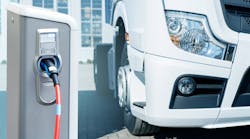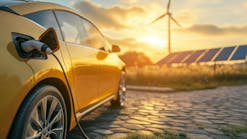The Electric Fleet Power Play: Future Proofing and Building the Business Case
Climate change policy, decarbonization and sustainability goals are driving the global push towards electrification, backed by rapid advancements in technology. This push also provides opportunities for companies to meet their objective of greater control over energy investments and cost certainty.
The rise in fleet electrification begs a few questions: Will the power supply be ready when the vehicles are? What will it cost utilities to expand service? What happens if the power goes out? With experts predicting hundreds of millions of electric vehicles (EVs) on the roadways within the next 10 to 20 years, the infrastructure needs to support this conversion are massive, and access to electricity could grow more competitive.
Utilities and energy companies alike have an opportunity to help drive zero-emission vehicle adoption and start preparing now for an electric future. Advance planning for everything from site selection considerations to power requirements as well as future scalability and resiliency will lead to cost-efficient, sustainable programs.
Future-Proofing
Advance planning and collaboration with utilities and energy companies will be critical in enabling cost-efficient, sustainable EV charging infrastructure programs. Questions abound around “future-proofing,” elevating the importance of discussions involving the anticipation of future needs and challenges while developing approaches that help minimize the impact of tomorrow’s stresses.
A little more than a decade ago, much of the talk was about the arrival of EVs. Today, light-duty electric vehicles are a common sight in several geographies, and these vehicles will only continue to proliferate once the charging infrastructure expands.
When looking at future-proofing, fleet owners — eager to ensure that their fleets will serve them well — want to make no-regret investments in fleets and charging infrastructure. This is challenging, as the market is undergoing rapid technological change. The vehicles will continue to improve, the chargers will get faster, the batteries will become more powerful, and everything will come down in cost.
Future-proofing really comes down to what the fleet manager wants; the type of fleet they have, and the required duty cycles, or how much the vehicle is used. Other things that must be considered will be grid and ecosystem-level effects, sustainability mandates, key marketplace drivers, infrastructure availability, sustainability, return on investment (ROI) and economics.
For operations that don’t require superfast chargers — where fleets can charge overnight, e.g., trucks that are sent out three times a day and the drivers are slip seated — the infrastructure being built today most likely will stand for the next 10 to 12 years. That 50KW charger for a van or heavy-duty truck is sufficient to supply that operation for years to come.
The more complicated networks are those operations where a medium- or heavy-duty truck requires a 20-minute refuel. This technology isn’t commercially available today, but the 1MW charging standard is on the horizon, and chargers adopting this standard should arrive on the market within the next few years. Fleet owners should exercise caution when considering significant investment in 350-KW chargers for fast charging use cases like long haul trucking, given that charging technology to better serve this need is advancing rapidly. Studies also show that most use cases are met by overnight charging, meaning the infrastructure built today should serve for years.
Building the Business Case
From the business case perspective, several countries are passing sustainability mandates to hasten the adoption of electric fleets. There’s also growing external pressure from state, federal and local governments, even as corporations continue to get on board with setting their own sustainability targets and decarbonization requirements.
By 2024, Paris and Madrid will have banned all diesel-powered passenger vehicles, with Barcelona, London and Rome following suit. Bloomberg reports that over the next decade, some 24 European cities — home to 62 million people — will ban diesel, including 13 cities that will bar all internal combustion engine cars. As such, delivery companies may want to consider proactively electrifying their delivery fleets to enable transit throughout these cities.
There also will be an increase in policies that limit the number of vehicles — especially delivery vehicles — within city centers. In Canada, where electricity is broadly inexpensive, the government continues to increase the carbon tax, which has gone up to US$ 10/ton for the past five years and will increase to US$ 15/ton until 2030. The Canadian government recently announced that the tax will reach US$ 50/ton by next year.
In the U.S., the Biden Administration is pressing for ambitious investment in electrified transportation by proposing a bipartisan, trillion-dollar infrastructure bill that sets aside US$7.5 billion for EV charging and US$73 billion to shore up the electric grid.
Regional adoption and support will also continue to play a major role in driving the policies and markets that will spur broader EV adoption in the U.S. For example, California has some of the most ambitious goals in the nation. They have presented a case study for the debate over asset ownership between utilities and the private sector. One of the largest challenges there stems from public commissions who must weigh in on utility ownership of charging infrastructure assets. Investors can look at models that have been successful in encouraging participation to analyze how capital has flowed in from private, public and utility players.
New York City has taken a different approach by setting goals for real estate. Real estate owners are now required, over an increasing scale, to use renewable energy sources for electricity or pay penalties. While there is no language specifically around fleet electrification, if owners are looking to purchase power agreements or other technologies that provide greener resources for the building as a whole, there's no reason not to factor fleet electrification capacity into those projects that already are underway, in order to avoid future fees for the transition to electric fleets.
The market will also have to work with utilities to consider energy procurement, whether that’s through renewable power sources — from wind or solar, for instance — or through power purchase agreements that help ensure a sustainable energy source.
And there’s the issue of not just how much power is needed, but also when. This refers to the rate — and volume — of flow. Multi-megawatt sites require a large volume of energy flowing at the right times. Space requirements for siting new equipment must also be taken into consideration; there are already existing depots that cannot accommodate all the chargers for a full fleet transition. As the industry looks at integrating microgrids and other advanced technologies, cost and space requirements will continue to be major considerations. Transit agencies with off-site land may be able to generate electrons elsewhere in their jurisdiction.
Electrification becomes a better deal each year. At the outset, it will afford a competitive advantage by enabling partnerships with companies and brands that want to use electric fleets. Over time fleet electrification will enable a competitive price advantage due to a forecasted operating cost reduction of 10 to 20 percent. Those without electric fleets — notably, those with diesel fleets — will be competitively disadvantaged.
These factors will all help drive the marketplace toward electrification. Fleet owners will need to plan for their infrastructure well in advance to make it happen.
Expanding to Other Applications
The policies and incentives around sustainability, carbon taxes, low-carbon zones and no-emission zones likely will continue, spreading electrification across many applications, including mining, marine, air and fleets.
Almost every mining company has publicly announced sustainability goals. Mining is notoriously energy-dependent, with heavy-duty vehicles that do everything from extracting materials from the mine site to sorting and loading them for shipment. Processing materials can involve grinding, separating, crushing, refining and smelting mined ore or other materials.
Given that these vehicles deposit enormous amounts of carbon dioxide into the atmosphere, the question arises: Is it possible to electrify these vehicles? Could original equipment manufacturers (OEMs) like Caterpillar and Komatsu develop electric battery-powered giant haulers or large dozers? Given the strength-to-weight ratio of these vehicles and the size of the battery required to power them, available technologies like green hydrogen may offer a better solution. There are ongoing pilot projects that are starting to be considered at scale.
Interesting work is also happening in the aviation sector, with between 250 and 300 vehicle OEMs pursuing electrified propulsion. There is some real progress happening with the technology, with some approaching certification. OEMs need to start thinking about the charging infrastructure for these vehicles. Such deliberation should include the gamut of considerations, from medium- and heavy-duty to transit applications, including the amount of power needed, resilience, safety and fuel choices.
It’s an evolving landscape as some OEMs now are investigating fueling aviation with hydrogen, with studies underway. It is currently unclear which option will dominate aviation in the future.
The Hydrogen Angle
While electric utilities and energy companies are focused on sourcing power, the industry should consider hydrogen and other alternative fuels when planning fueling infrastructure as part of a no-regrets technology play. After being included in a roadmap, the technology can be feathered in as it becomes more cost-effective. While hydrogen is an excellent fuel, it can also be used as energy storage. To really help lower demand costs, entry into hydrogen might come from a storage perspective.
Engaging hydrogen technology to store energy from renewable sources will help lower demand charges, and that same infrastructure over time can be converted to fuel for hydrogen vehicles. Fleet owners should look at the operational goals and requirements — and which technologies are available both short- and long-term — and lay out a blueprint that provides flexibility to meet their needs across time.
Utilities will need various tools, and hydrogen is an admittedly complex one that needs to be understood from all angles. As the technology evolves and the business case matures, expect to see hydrogen play a larger role when electric supply falls short or where long routes need to electrify. Only then will it make financial sense.
These actions — and so many others — will be critical when it comes to driving electrification infrastructure and access to electricity. By preparing today, utilities and energy companies have the opportunity to grow zero-emission vehicle adoption and ensure our electric future.





